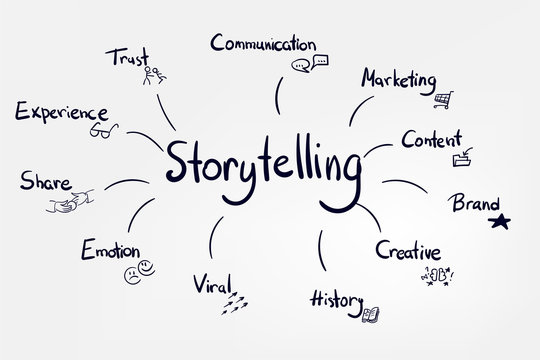
Marketers are constantly looking for strategies to attract as many consumers as possible, falling prey to the tried-and-true tricks of urgency, fear, discounts, and sales as bait. But even though they might be effective the first time, the second time, or even the third time, they rarely produce long-lasting effects. Your new marketing best friend is storytelling if you want to increase the “like-know-trust” factor.
By incorporating storytelling into your marketing, you can attract attention, persuade, and inspire potential customers—all the qualities necessary to close a deal. It simultaneously encourages intimacy and builds trust, which are both necessary elements of a fulfilling relationship.
The first humans used storytelling as a means of communication long before marketing was a thing in our universe. They would transmit verbal tales from one generation to the next. Stories still serve as a means of spreading messages and make up a significant portion of our entertainment today. What are some benefits of including storytelling in your marketing plan, then? Let’s talk about how crucial storytelling is to marketing.
Consider this: Would you rather purchase from a logo or the real person operating the company? The latter, I think. We want to understand who we are buying from, their core beliefs, and the general direction that their money will be going. In a similar vein, narrative-based copy gives your company human values and characteristics, which makes it more approachable and relatable. Would you be compelled to make a purchase from someone whose website, for example, was uninspired, overly “keyword-centered,” and generally gave the impression that it was run by robots? Most likely not.
Your product or service was ultimately developed to benefit people. Utilizing stories strengthens your sense of community. And people make purchases from those they feel comfortable doing business with.
The value of storytelling in marketing is that it engages your target audience. By doing this, you’re influencing your customer to care about the same things that you do. By doing this, you’re influencing your customer to care about the same things that you do.
Every brand has certain values and traits that customers connect with, whether you try to or not. A brand personality is made up of many different components, such as visuals, a website, messaging, and now more than ever, opinions on crucial issues. It refers to “who” a customer is speaking with. In fact, 64% of consumers worldwide said they would either buy a product or boycott it based on their social or political beliefs. Your company’s story will be distinctive and appealing to your community if you take risky positions and emphasize your company values.
Your audience is transported into a different world by stories. They feel the need to purchase your product rather than just thinking about it as they move around the world you created. Like the Harry Potter books, for example. With the fictional series, J.K. Rowling effortlessly won over millions of hearts. Fans all over the world were compelled to go to theme parks, drink butterbeer, and bite their fingernails while binge-reading the most recent volume. They considered more than just making purchases; they also considered what it would be like to attend Hogwarts.
You’re now prepared to use storytelling to build your brand. But if you’re not really a storyteller, where do you even begin? Here are 3 straightforward yet effective strategies to help you grow your company.
The research stage is the first step in any successful story. So put your hands to work and begin researching your target audience by drawing a map of their purchasing journey, then use this to create your hero’s story.
It’s time to write your story now that you understand how your product or service benefits your client. Two characters are required for your story: a hero and a helper. The ideal customer persona or the person who most needs your products is the hero. The helper, on the other hand, represents your brand. They transport the hero from their current location to their desired location.
Now, let’s look at the third step.
In storytelling marketing, we use feelings rather than logic to guide our audience.
Identify emotional trigger words like sparkly, faithful, sabotage, or remarkable as you continue to work on your copy. To evoke emotion, consistently use these words throughout your copy. Consider the emotional needs that your product or service addresses, and then pretend that you’re speaking to a person to give your message a human touch.
Share your concerns or fears while incorporating how you have experienced similar emotions in the past. Make sure your audience can relate to the story.
Analyze your data again to discover the emotional drivers behind your customers’ goals.